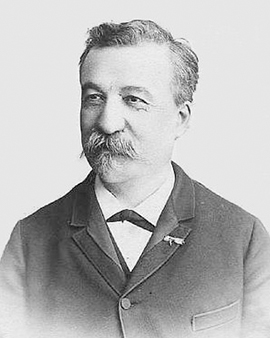


Émile Munier, born in Paris on June 2, 1840, is a historic figure in French art whose legacy remains alive today through exclusive art prints. Growing up in the alleys of St. Marcel, he was part of a family of creative craftsmen who introduced him to the fine art of drawing and painting at an early age. His talent was further strengthened by his training with Abel Lucas and his later association with William Adolphe Bouguereau, which led him to develop a deep affinity for academic art. The 1860s marked the beginning of his professional recognition, when Munier won three Beaux-Arts medals and exhibited his work at the prestigious Paris Salon. His affinity with Bouguereau and their shared artistic synergy found expression in Munier's paintings, which reflected the quality and composition of Bouguereau's masterpieces. Munier also collaborated with Emile Galle, a prominent glass designer, and forged a name for himself in the world of art.
When Munier gave up his work at the Tapestry Manufactory in 1871 to devote himself fully to painting, a new phase of his artistic career began. Of particular note is his painting "Angel Comforting His Grieving Mother," commissioned by Jane Stanford to immortalize her son, who died at an early age. This artwork, now on view at Stanford University's Cantor Center for the Visual Arts, is a shining example of the emotional depth and technical mastery found in Munier's work. With his signature painting, Three Friends (1885), which depicts a little girl playing with her pets, Munier definitively established himself as one of the leading "painters of little children and their pets." Today, high-quality art prints of this and Munier's works are sought after worldwide. They can be found in private collections and museums, including the New Orleans Museum of Art, which also houses a portrait of Munier that he painted for American art collectors Chapman H. Hyams and his wife. Until his death in 1895, Munier continued to enchant the world with his depiction of rural, mythological and religious subjects, as well as animal scenes, landscapes and seascapes. Today, we can enjoy Munier's extraordinary talent thanks to the quality and finesse of the fine art prints that reproduce his works. His legacy lives on, carried by the magic of his art captured in each art print.

Émile Munier, born in Paris on June 2, 1840, is a historic figure in French art whose legacy remains alive today through exclusive art prints. Growing up in the alleys of St. Marcel, he was part of a family of creative craftsmen who introduced him to the fine art of drawing and painting at an early age. His talent was further strengthened by his training with Abel Lucas and his later association with William Adolphe Bouguereau, which led him to develop a deep affinity for academic art. The 1860s marked the beginning of his professional recognition, when Munier won three Beaux-Arts medals and exhibited his work at the prestigious Paris Salon. His affinity with Bouguereau and their shared artistic synergy found expression in Munier's paintings, which reflected the quality and composition of Bouguereau's masterpieces. Munier also collaborated with Emile Galle, a prominent glass designer, and forged a name for himself in the world of art.
When Munier gave up his work at the Tapestry Manufactory in 1871 to devote himself fully to painting, a new phase of his artistic career began. Of particular note is his painting "Angel Comforting His Grieving Mother," commissioned by Jane Stanford to immortalize her son, who died at an early age. This artwork, now on view at Stanford University's Cantor Center for the Visual Arts, is a shining example of the emotional depth and technical mastery found in Munier's work. With his signature painting, Three Friends (1885), which depicts a little girl playing with her pets, Munier definitively established himself as one of the leading "painters of little children and their pets." Today, high-quality art prints of this and Munier's works are sought after worldwide. They can be found in private collections and museums, including the New Orleans Museum of Art, which also houses a portrait of Munier that he painted for American art collectors Chapman H. Hyams and his wife. Until his death in 1895, Munier continued to enchant the world with his depiction of rural, mythological and religious subjects, as well as animal scenes, landscapes and seascapes. Today, we can enjoy Munier's extraordinary talent thanks to the quality and finesse of the fine art prints that reproduce his works. His legacy lives on, carried by the magic of his art captured in each art print.
Page 1 / 1






